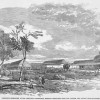Meerut
Meerut is a city in the state of Uttar Pradesh, northern India, located 70km northeast of New Delhi. It came under Mughal rule in the sixteenth century and saw Sikh and Maratha invasions in the eighteenth century. In 1803, the Marathas ceded the territory to the British, and the cantonment of Meerut was set up in 1806. The city is famous for being the starting point of the 1857 rebellion against British rule. In 1946, the city hosted the last session of the Indian National Congress, before the Indian independence in 1947.
Coordinates
Latitude: 28.996298449159
Longitude: 77.706127166748
Longitude: 77.706127166748


